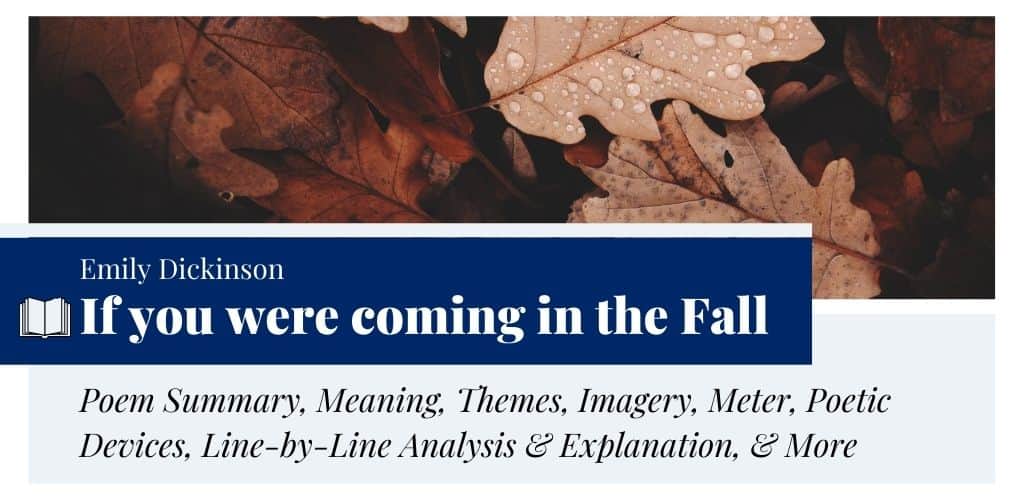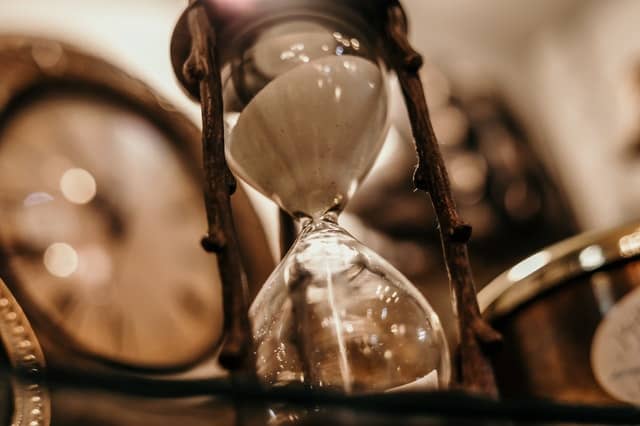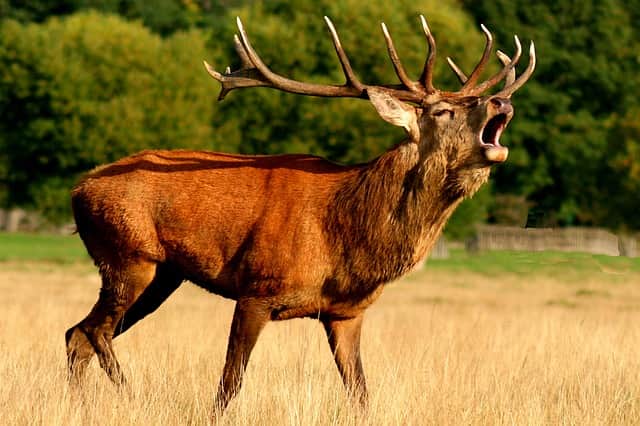If you were coming in the Fall by Emily Dickinson
“If you were coming in the Fall” is written by one of the greatest lyric poets of all time, Emily Dickinson. The poem first appeared in her 1890 collection called Poems, and later as the 511 number poem in The Complete Poems of Emily Dickinson by Thomas H. Johnson in 1955. This poem is highly characteristic of Dickinson, being both seemingly simple while being enveloped in mystery at the same time. It deals with the emotions of longing, pain at being separated from a lover, as well as eternal love. Hope and longing, therefore, become the prevailing theme of the poem.
- Read the full text of “If you were coming in the Fall” below:
If you were coming in the Fall by Emily Dickinson If you were coming in the Fall, I'd brush the Summer by With half a smile, and half a spurn, As Housewives do, a Fly. If I could see you in a year, I'd wind the months in balls – And put them each in separate Drawers, For fear the numbers fuse – If only Centuries, delayed, I'd count them on my Hand, Subtracting, till my fingers dropped Into Van Dieman's Land. If certain, when this life was out – That yours and mine, should be I'd toss it yonder, like a Rind, And take Eternity – But, now, uncertain of the length Of this, that is between, It goads me, like the Goblin Bee – That will not state – its sting. - from The Complete Poems of Emily Dickinson (1955)

Summary
Dickinson’s “If you were coming in the Fall” captures the innermost feelings of a lover, missing the presence of her significant other. The speaker in the poem draws up various measures of time which she would be willing to pass if it means she could be reunited with her lover. She would be willing to brush away the uncertainties of seasons, months, years, and even centuries – as if it is child’s play if, at the end of this, the lover and the speaker can spend their lives together for eternity.
Furthermore, the speaker says that if their reunion is bound to happen only after the passing of their mortal lives, she will toss away her life as if it were meaningless compared to the eternity she will cherish with her lover. However, as the last stanza suggests, the uncertainty of their unification gives the speaker unimaginable pain and distress: “That will not state – its sting.”
Meaning
The poem “If you were coming in the Fall” deals with the other aspect of love, a shift from the happy and romantic feelings—the pain and longing—that is inevitable when lovers are forced to live apart. Dickinson articulates how the passage of time means nothing to lovers who are spiritually close. Her speaker casually dismisses the length of months, years, and centuries that she will have to live through without her lover. Yet, she feels the pangs of cruel time lingering around like a “Goblin Bee.”
The speaker seems to be trying to soothe her yearning heart throughout the poem by trivializing time, which keeps reminding her of her lover’s absence. However, the poem ultimately champions the transcendentalist approach to the permanence of love, which is more significant than time and life itself.
Form, Rhyme Scheme, & Meter
Form
“If you were coming in the Fall” is a lyric poem that is written from the perspective of a first-person speaker. It is written in the form of a love letter to the speaker’s dear one who is far away from her. The text comprises five quatrains or stanzas, having four internally rhyming lines each. It is rhythmic and has a consistent metrical structure that is described further in the following sections. However, Dickinson broke the “acceptable” conventions of poetry in the 19th century, which she was particularly known for.
Rhyme Scheme
The poem is written using the ABCB rhyme scheme. It means that the second and fourth lines of each stanza ends with a similar rhyme. For instance, in the first stanza, “by” and “Fly,” and “Hand” and “Land” in the third stanza.
It also consists of slant rhymes or half-rhymes, characteristic of Dickinson’s poetry. This can be seen in the rhymed pairs, “balls” and “fuse,” and “between” and “sting.”
Meter
The poetic meter of “If you were coming in the Fall” alternates between iambic tetrameter and iambic trimeter. This scheme is followed throughout the poem consistently. In each quatrain, the first and third lines contain four iambs (unstressed-stressed), and the rest contains three iambs. Let’s have a look at the scansion of the first two stanzas.
If you/ were com/-ing in/ the Fall,
I’d brush/ the Sum/-mer by
With half/ a smile,/ and half/ a spurn,
As House/-wives do,/ a Fly.
If I/ could see/ you in/ a year,
I’d wind/ the months/ in balls –
And put/ them each/ in sep/-(a)rate Draw(e)rs,
For fear/ the num/-bers fuse –
Poetic Devices & Figurative Language
Even though “If you were coming in the Fall” is simple at the surface, it contains a number of literary devices that illustrate its major themes.
- Simile: The uncertainty regarding the passage of time is directly compared to the painful “sting” of a cruel, mischievous “Goblin Bee” in the line, “It goads me, like the Goblin Bee –/ That will not state – its sting.”
- Metaphor: In the first stanza, the poet compares “Summer” to a “Fly,” two distant ideas fused together bearing a similar meaning. Besides, “months” are compared to woolen balls in the second stanza.
- Hyperbole: An instance of hyperbole can be seen in “Subtracting, till my fingers dropped/ Into Van Dieman’s Land.” Dickinson also uses this device in the lines, “I’d toss it yonder, like a Rind,/ And take Eternity.” Here, the speaker talks about tossing her “life” away like a peel.
- Repetition: In the line, “With half a smile, and half a spurn,” the word “half” is repeated for poetic effect. Besides, there is a repetition of “If” in this poem at the beginning of the first four stanzas. It emphasizes the uncertainty of the speaker’s unification with her lover.
- Enjambment: It occurs in the following lines: “Subtracting, till my fingers dropped/ Into Van Dieman’s Land” and “But, now, uncertain of the length/ Of this, that is between.”
- Euphemism: This can be seen in the line, “If certain, when this life was out –” where the harsh idea of “death” is substituted with a milder expression.
- Alliteration: It occurs in “For fear,” “this, that,” “state – its sting,” etc.
Line-by-Line Analysis and Explanation
Lines 1-4
If you were coming in the Fall,
I’d brush the Summer by
With half a smile, and half a spurn,
As Housewives do, a Fly.
In the first stanza, the speaker addresses an unknown person, who is assumed to be her lover. She lays bare the significant themes in the poem, uncertainty, time, and longing. She tells her lover that she would happily spend the entire summer alone as if it were as easy as the swatting/shooing off a fly if her lover were to come and meet her in the fall/autumn. She wouldn’t feel the pain of waiting at all if there was a slight possibility of his return.
Lines 5-8
If I could see you in a year,
I’d wind the months in balls –
And put them each in separate Drawers,
For fear the numbers fuse –
The second stanza continues the same idea that the first one established. Now the speaker refers to a longer timeframe than the initial one she spoke of. According to her, even if the period of her lover’s absence extended to a year instead of just a season, she would still wait patiently. However, this stanza brings in a hint of uncertainty and fear on the part of the speaker, as she is now a bit mechanical in her way of explication. The ease communicated through stanza one now turns into fear, as is indicated in the last line of this stanza: “For fear the numbers fuse –”.
In this stanza, the speaker compares the length of months to woolen balls. She winds them up and puts them in separate drawers; otherwise, they would fuse. It would create a disturbing situation, further increasing her pain. Besides, the speaker winds the woolen balls as her lover is not in proximity. If he is with her, she would bring the wools out and weave a sweater for the coming winter. As waiting is prolonged, it is useless to bring them out and weave unnecessary dreams concerning his return.
Lines 9-12
If only Centuries, delayed,
I’d count them on my Hand,
Subtracting, till my fingers dropped
Into Van Dieman’s Land.
In the third stanza, the speaker increases the waiting interval even further to say that even if she has to wait for centuries to see her lover, she will do so without blinking an eye. However, with every passing stanza, her restlessness only seems to increase as she says she will keep counting the centuries on her fingers (indeed, a tedious task!) till they drop. By counting them for so long, her fingers would become useless and “drop” off her hand like vestigial organs.
The speaker wants to undertake such an uphill task to distract herself from the pain of separation. The phrase “Van Dieman’s Land” is a reference to Tasmania in Australia, which was earlier known as Van Diemen’s Land before European colonization. The colonizers used the land as penal colonies to transport convicts from their mainland. The speaker says that she will count the centuries on her fingers till they fall off her hand in the faraway “Van Dieman’s Land” and disappear into nothingness.
Lines 13-16
If certain, when this life was out –
That yours and mine, should be
I’d toss it yonder, like a Rind,
And take Eternity –
In the fourth stanza, Dickinson offers a resolution to the speaker’s aching heart. The waiting time now moves from centuries to a lifetime, and the speaker expresses that she will toss away her life like the “Rind” (outer layer of fruit). Like the peel is useless and cut off before eating, the speaker’s life seems meaningless without her lover. There is one condition, if they are sure to be united after death, she will throw such a precious away.
The last line, “And take Eternity,” suggests that the spiritually united lovers embody the idea of immortal, eternal love. They can spend an eternity together, free from the clutches of cruel time after their mortal death.
Lines 17-20
But, now, uncertain of the length
Of this, that is between,
It goads me, like the Goblin Bee –
That will not state – its sting.
The last stanza of “If you were coming in the Fall” brings the reader back from the imagination to reality. While the idea of eternal love is very endearing to the speaker, she still has to live her life on earth without any certainty of her lover’s return. Philosophizing about the reunion of souls does not ease the pining that she feels now. She says the uncertainty of seeing her lover and living in loneliness is similar to the “Goblin Bee” hovering around with an invisible “sting” of reality.
She equates her emotional pain to physical suffering through this image, and this highlights the extreme distress she feels throughout the poem. The final stanza, in a way, wraps up the ideas put forth in all the previous ones. While the speaker has been going on about how she will patiently endure time, the final stanza points out how difficult it is to do so in reality. The uncertainty grips her and heightens her turmoil, like a bee buzzing around and stealing the life’s honey (essence) unnoticed. She is aware that reality will sting her deeply in the near future.
Themes
Separation & Longing
The central theme of the poem is separation and longing. The speaker in “If you were coming in the Fall” is desperate to be with her lover, but the cruelties of time and distance forbid her from doing so. The idea of yearning is also heightened as one sees only the speaker’s point of view throughout the poem, the heartache and agitation she feels due to the distance. However, no information is provided as to whether the lover feels the same intensity of longing as the speaker. The conflict of separation and yearning is solved through the idea of the immortality of love.
Eternal Love
The permanence or immortality of love is the second most important theme in the poem. While the poem wrestles with the idea of physical distance keeping lovers apart, it also introduces the idea of the “union of the souls.” The speaker is ready to go an entire lifetime without catching even a glimpse of her lover; she believes an eternity of togetherness awaits after her mortal death. The idea put forth is that since they are one at heart and soul, their love has achieved a state of permanence that is untouched by the temporary nature of mortal existence.
Imagery
Dickinson exemplifies the feel and depth of the poem through simple yet unusual organic imagery. All the images used seem related to the speaker’s immediate surroundings in the house she lives in. For instance, the lines, “I’d wind the months in balls –/ And put them each in separate Drawers,” bring out a highly homely, solitary feeling in the poem. It also heightens the immense loneliness that the speaker feels due to being separated from her lover. It may even be interpreted that the absence troubles the speaker so much that she has withdrawn from the social world and spends all her time thinking about him and their reunion.
The use of this kind of imagery also mirrors Dickinson’s own life. She was known to live a highly secluded, isolated life, shrouded in obscurity and away from the social world’s excesses. She had only a small group of close friends with whom she shared her life. The speaker in the poem seems to reflect Dickinson’s own life and thoughts.
Furthermore, Dickinson also uses visual imagery in the lines, “I’d wind the months in balls –/ And put them each in separate Drawers,” and tactile imagery in “I’d count them on my Hand,/ Subtracting, till my fingers dropped.” In the last stanza, there is a use of auditory imagery in the goading of the “Goblin Bee.”
Tone
The poem takes on an optimistic tone at first, with the speaker ready to disregard the length of time to be spent in anticipation of her lover. However, on deeper analysis, it appears that the speaker is possibly trying to convince her own tumultuous heart as it grows more and more troubled at the absence of her significant other. The poem then takes a somewhat restless tone, as the poet tries to reason with herself and the growing uncertainty which time offers her.
However, the tone that is maintained throughout the poem is one of desperation shrouded by hopefulness, as the speaker is convinced that no matter how much time passes, she and her lover will ultimately be reunited, even if that is after their death. Their soulful love transcends the mortal realm and the authority of the time.
Historical Context
Emily Dickinson (10th December 1830 – 15th May 1886) is one of the greatest American poets of all time. She is considered one of the most important poets during the 19th-century; however, only 10 of around 1,800 of her poems were published during her lifetime. Most of her fame lies in posthumous publications.
Dickinson is known for leading a life of obscurity, isolated from the world. The ideas of mystery and isolation also become reflected in her poetry very evidently. She is considered a visionary by later critics who commended her poetry for its unique style but intense themes and for her modernist deviation from prescribed standards of poetry like rhyming, syntax, and punctuation. The stylization of the title “If you were coming in the Fall,” which contains capitalization, is a feature of this very deviation.
The two essential volumes of her poetry are Poems (1890), published by two of her friends, Higginson and Todd, and The Complete Poems of Emily Dickinson (1955) by Thomas H. Johnson. The poem “If you were coming in the Fall” appears in Book II (entitled “Love”) of Poems. Johnson dates the composition of the poem (numbered 511) back to 1862. The period of 1861-1865 is regarded as the most creative period of Dickinson’s life. In 1862, she composed a total of 366 poems and around 800 poems from 1860 to 1864.
Questions and Answers
Emily Dickinson’s poem “If you were coming in the Fall” is about the pining of a speaker who would have waited for a long time if she could be reunited with her lover. The uncertainty of his return lingers in her mind, making her spirit restless.
Dickinson’s use of peculiar imagery to describe concepts like time, seasons, days, and months become important in this poem. She gives these concepts qualities of ordinary, everyday objects and uses that to extend her idea of the longing and aching of the speaker. The speaker opens her heart up in the poem, and yet it is shrouded by an air of uncertainty and desperation. Readers will know nothing about the speaker’s lover or the nature of their relationship till the end.
According to Thomas H. Johnson, Dickinson wrote this poem in 1862. This poem was first published in Dickinson’s first collection, Poems, in 1890. It bears the 511 number in Johnson’s Collected Poems(1955), the first scholarly publication of Dickinson’s poems.
This poem is about a speaker’s wish to wait for a lifetime if she is sure her love will return. In order to describe the time of waiting, the speaker makes use of several metaphors. In the end, she describes how uncertainty buzzes through her mind like a “Goblin Bee,” snatching all her hope away.
In this poem, the speaker talks about how she would pass her time in waiting for her lover’s return. She talks about how useless time and life are for her in comparison to an eternity with her lover. Finally, she wakes up from her daydreaming and confronts reality.
The poet beautifully and rationally arranges the idea in ascending order of importance. Firstly, her speaker talks about brushing away the “Summer.” Then she goes on to include the months in a year, centuries, and finally a lifetime to refer to the expected waiting time for her lover’s return. Lastly, she realizes that the length of waiting is “uncertain” and may prove futile.
The speaker says she would pass “Summer” away like housewives brushing away a “Fly” from their food. She would spurn the beauty of this season half-heartedly.
The speaker addresses her lover as “you.” She talks about what she would do if he were to return.
The speaker’s mind is in a turbulent state, torn between desperation and hopelessness. Her repetition of “If’s” and the final “But” reflects how earnest she is for unification yet, at the same time, uncertain of her lover’s return.
Dickinson uses a simile in the line, “It goads me, like the Goblin Bee –”. Here, “It” refers to uncertainty. It is compared to a bee that steals the nectar away from flowers.
In the last stanza, the speaker finally confronts reality. She describes how uncertainty annoys the speaker like a “Goblin Bee.” It will not explicitly prick her with the “sting” of reality.
The phrase “Goblin Bee” contains a personification. Dickinson compares the bee to a goblin, a mischievous, ugly creature resembling a dwarf. In folklore, goblins are seen stealing one’s possessions away. Bees steal the nectar (the most desired thing in a flower apart from its beauty) away and store it in their hives as goblins do. In the poem’s context, the “Goblin Bee,” a metaphor for “uncertainty,” steals the nectar of the speaker’s life, “hope” away.
The words “you” and “yours” indicate that this poem is addressed to someone the speaker loves the most.
This poem deals with the themes of separation, heartache, and yearning. The idea of eternal love is given the center stage here, as the speaker is willing to wait all her life for her soul to be one with her lover after their death.
Some important literary devices used in the poem are simile, metaphor hyperbole, repetition, enjambment, and euphemism. These devices highlight the major themes of the poem and heighten the poetic thoughts.
This piece is written using the ABCB rhyme scheme. It means the second and fourth lines of each stanza rhyme together. For instance, in the first stanza, “by” rhymes with “Fly.”
Similar Poems about Pain and Separation
- “The Nightingale” by Sir Philip Sidney — This poem describes how a speaker’s heartache intensifies after listening to the mournful song of a nightingale.
- “A Wounded Deer – leaps highest –” by Emily Dickinson — This poem revolves around the themes of desperation, appearance vs. reality, and death.
- “Monna Innominata: I wish I could remember that first day” by Christina Rossetti — This poem is about a speaker’s regrets while thinking about her first love.
- “The Awakening” by James Weldon Johnson — In this poem, Johnson uses a “bee” as a metaphor for God and compares himself to a “rose.”
External Resources
- About Van Diemen’s Land — Explore more about this European colony and try to find why the poet refers to this place.
- Full text of Poems (1890) — Read some other poems published in Dickinson’s first collection of poetry.
- The Love Life of Emily Dickinson — Read about Dickinson’s love life and the speculation concerning her correspondence with Judge Otis Lord.
- About Emily Dickinson — Learn about the poet’s life and works and explore some of her best-known poems.
- Biography of Emily Dickinson — Explore more about the poet’s life and career.







